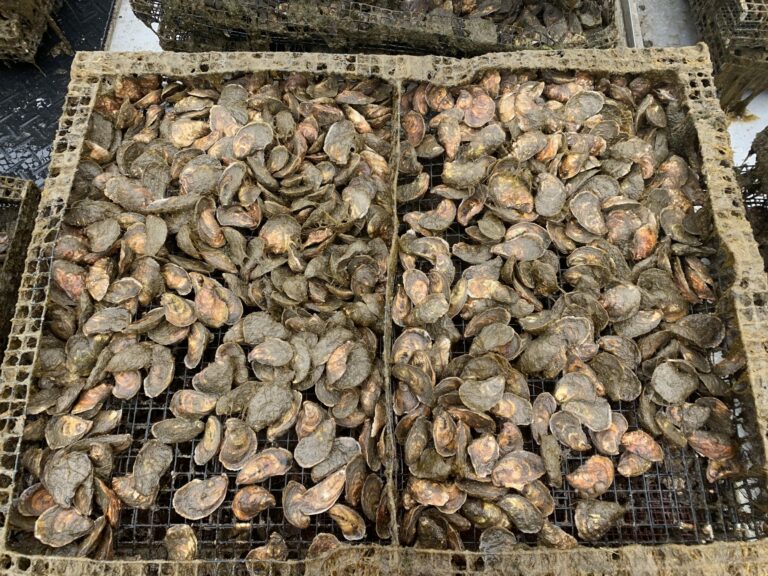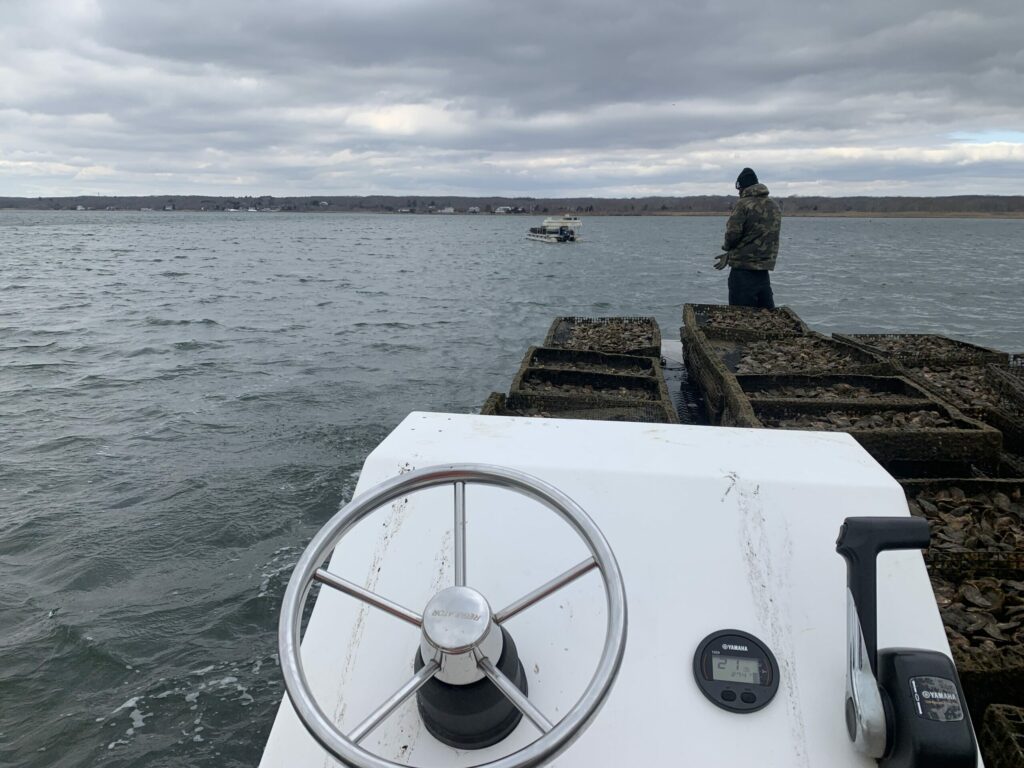Others See an Eyesore
By Cynthia Drummond / ecoRI News contributor
Oysters
provide food, clean the water, generate jobs and create fish habitat, but
shellfish farms have encountered opposition from residents who say they mar the
appearance of their views and interfere with their use of the water.
Two
recent public presentations on aquaculture focused on restorative aquaculture and
how it is used to improve marine ecosystems in the United States and the
different ways people perceive aquaculture facilities that grow shellfish. The
talks — on March 21 and April 6 — were part of a series of educational webinars
organized by the Narragansett Bay Special Area
Management Plan (SAMP) of the Coastal Resources Management
Council (CRMC).
Northeastern
University graduate student Kelsey Schultz discussed the results of her study
of public perceptions of shellfish
aquaculture on the Atlantic Coast. Also presenting was Stephen
Kirk, coastal programs manager at the Massachusetts chapter of The Nature
Conservancy. (None of the research for either presentation was conducted in
Rhode Island.)
Pandemic help for oyster farmers
Kirk described the Supporting Oyster Aquaculture
and Restoration (SOAR) program, which helped the oyster
aquaculture industry survive the COVID-19 pandemic when restaurants were forced
to close, shutting off the market for raw oysters.
 |
| Matt Behan grows his Ninigret Nectar oysters in cages in Ninigret Pond. Behan is awaiting state approval to expand his lease to 9.5 acres. (Matt Behan photo) |
“When
things first started shutting down in the U.S., it really disrupted the demand
for half-shell market oysters, which is the dominant product in our region …
decreasing the demand and ultimately leaving surplus product, surplus oysters,
on the farms, which is okay from an ecological standpoint, not so good from the
business perspective of the oyster farmer,” he said.
The goal
of the program, which was also supported by The Pew Charitable Trust, the
National Oceanic and Atmospheric Administration (NOAA) and the U.S. Department
of Agriculture (USDA), was to use the unsold oysters that had grown too large
for the raw half-shell market to create oyster reefs.
“This is
just one tool that we hope to use and hope to support to improve coastal
ecosystem function,” Kirk said.
Oysters
are prodigious filter feeders. A single oyster can filter up to 50 gallons of
water a day. With wild oyster reefs in steep decline, the unsold, farmed
oysters were used instead. The SOAR collaborators bought millions of farmed
oysters and sent them to restoration sites.
“We were
able to purchase three and a half million oysters [and] place them on 40 acres
of reef at 25 restoration sites,” Kirk said.
The
program paid 125 growers for their oysters during the pandemic, preserving 450
jobs. In the coming years, SOAR is expected to buy 5 million oysters, which
will be used to rebuild declining native shellfish reefs at 20 restoration
sites.
The
Ocean State is not participating in the SOAR initiative, but the state already
has a program of its own. Working with the USDA’s Natural Resources
Conservation Service and The Nature Conservancy, the Rhode Island Department of
Environmental Management (DEM) has implemented a farmer-supported oyster reef restoration program that
Kirk said he has been watching closely.
“It’s
something that I, in Massachusetts, have been really interested in
understanding how that works, and we’re actively trying to replicate that in
Massachusetts,” he said.
Farmed
oysters have been used, with varying degrees of success, in restoration
projects in the Quonochontaug and Ninigret salt ponds and in upper Narragansett
Bay.
John
Torgan, R.I. director of The Nature Conservancy, said water in the salt ponds
proved to be too salty for the oysters on the small experimental reefs to
thrive.
“It’s
not water quality, it’s just that salinity,” he said. “Different kinds of
predators and diseases affect the oysters and also sedimentation, but a spring
flood event seems to be one of the big factors in the success of wild oysters.”
Torgan
explained the focus of the oyster reef projects has moved to upper Narraganset
Bay, where there is more space and the water quality has improved to the point
that it can now support oysters.
“We’re
really shifting our focus now to look at upper Narragansett Bay and the
tributaries to Narragansett Bay, places that, historically, were too polluted
to consider investing in restoration, but now have been improved to the point
where restoration can work,” he said. “Restoration can have a lot of benefit,
and we have not encountered the same kind of user conflicts in the bay and in
the rivers.”
Coastal user conflicts
Opposition to aquaculture applications has prevented some farms from expanding or being approved. Schultz discussed her research on the ways coastal residents perceive local aquaculture and how those attitudes can encourage or constrain shellfish farming.
“There’s
a large gap between current aquaculture production and the potential for
aquaculture production,” she said. “This can largely be attributed to negative
perceptions of aquaculture.”
Surveys
of coastal residents were conducted in four regions: Maine and Massachusetts;
New York and New Jersey; Virginia and North Carolina; and Georgia and Florida.
Schultz
found most people support the concept of aquaculture, but those who said they
were already knowledgeable about shellfish farms were more inclined to support
such operations.
 |
| Oyster grower Matt Behan moving gear on his farm in Ninigret Pond. The gear is submerged, so it cannot be seen on the surface. |
Gear
type is also a factor in determining whether people will support a shellfish
farm. Schultz said most of those surveyed for the study preferred “low-relief,”
or the least-visible gear, although those who were more familiar with, or
connected to, the local fishing economy rated high-visibility gear favorably.
Schultz
concluded that public education and outreach to coastal residents would help
them appreciate the ecological benefits of oysters and increase the acceptance
of aquaculture.
Local outreach
Matt Behan understands the importance of public outreach. An oyster grower and
president of the Ocean State Aquaculture
Association, Behan leases 7.75 acres in Ninigret Pond and is waiting
for the CRMC to approve his application to expand his operation by two
additional acres.
Behan,
who uses submerged gear but has nevertheless encountered opposition to his
farm’s expansion, is a firm believer in compromise.
“Every
time I’ve applied, there’s always been a couple people out there who had
something to say and there was a little bit of a conflict and we’ve gotten
through it,” he said. “I think that last expansion that I applied for, I wanted
a different configuration, but all these people agreed that we should put it in
a different spot where it would be a little bit less intrusive, and I said
‘That’s fine. I don’t mind moving it to where you think it’s a little bit
better situated.’ As long as I get the acreage, it’s fine.”
Behan
believes improving public perceptions of shellfish farms, particularly those
located in Rhode Island’s heavily used salt ponds, largely depends on growers
respecting other users.
“We want
to try to push the ‘Be a good neighbor’ thing as hard as we can,” he said.
“There’s a give and take with that. I was talking about the yield, the amount
that you can get to market, and you know, one method, maybe you can get a
little bit more to market, but if you’re causing some serious user conflicts,
you have to factor that in.”
